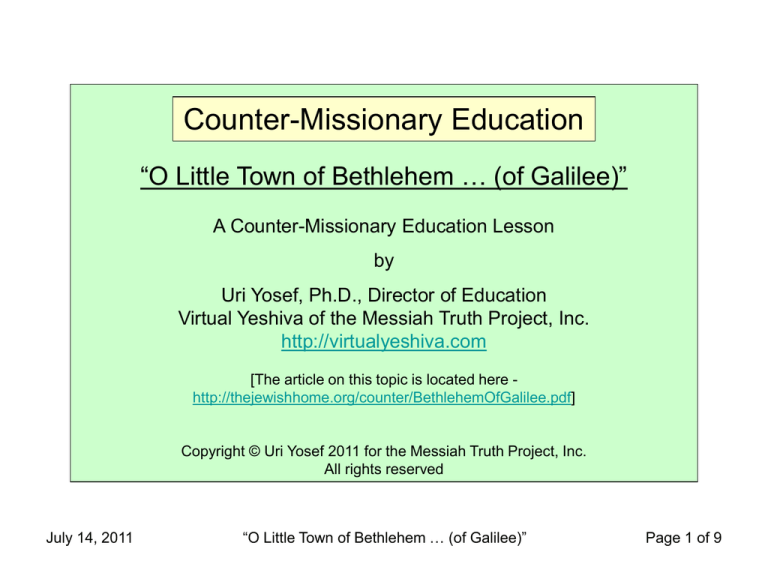
Counter-Missionary Education
“O Little Town of Bethlehem … (of Galilee)”
A Counter-Missionary Education Lesson
by
Uri Yosef, Ph.D., Director of Education
Virtual Yeshiva of the Messiah Truth Project, Inc.
http://virtualyeshiva.com
[The article on this topic is located here http://thejewishhome.org/counter/BethlehemOfGalilee.pdf]
Copyright © Uri Yosef 2011 for the Messiah Truth Project, Inc.
All rights reserved
July 14, 2011
“O Little Town of Bethlehem … (of Galilee)”
Page 1 of 9
Introduction
The city of Bethlehem (of Judea), venerated by Christians as the birthplace of Jesus, the
Messiah of Christianity, is located about six miles (~10 kilometers) south of Jerusalem and
about 70 miles (~110 kilometers) south of Nazareth.
The belief that Bethlehem is the birthplace of Jesus has its origin in a verse from the
Christian “Old Testament”, claimed to be a “messianic prophecy” that was fulfilled by Jesus,
as described in the New Testament.*
Two distinct geographical places named ( בֵּית ֶלחֶםBEIT LEhem), Bethlehem, are mentioned in
the Hebrew Bible: One, the familiar city that is located in the territory of the Tribe of Judah,
is referenced on 40 occasions. The other, a more obscure one referenced only once (as
one of the 12 named cities in the territory of the Tribe of Zebulun), is located in the lower
Galilee some four miles (~7 kilometers) northwest of Nazareth:
Joshua 19:15 - And Kattath, and Nahallal, and Shimron, and Idalah, and Bethlehem; twelve cities with their villages.
The existence of these two cities that bear the same Hebrew name בֵּית ֶלחֶם, combined with
two different birth narratives in the Gospel of Matthew and the Gospel Luke along with a
somewhat odd account in the Gospel of John, has led several scholars, as far back as the
late 19th century CE, to suggest the possibility that Bethlehem (of Galilee) is the more
likely place where Jesus was born. However, without physical evidence, this remained a
theory for over 100 years. The archaeological evidence to support this theory came from
excavations carried out in the area of Bethlehem (of Galilee) during the period 1992-2003,
and this will be the focus of the present lesson.
July 14, 2011
“O Little Town of Bethlehem … (of Galilee)”
Page 2 of 9
A Map of the Land of Israel in the First Century CE
Legend
● Bethlehem of Galilee
● Nazareth
● Jerusalem
● Bethlehem of Judea
[Source: Bible History Online (http://www.bible-history.com/maps/palestine_nt_times.html)]
July 14, 2011
“O Little Town of Bethlehem … (of Galilee)”
Page 3 of 9
New Testament Accounts Related to the Birthplace of Jesus
The Nativity (& related events) according to the Gospel of Matthew
Summary: The account in the Gospel of Matthew starts with the birth of Jesus in
Bethlehem of Judea (Matthew 2:1-6), includes a sojourn in Egypt (Matthew 2:13),
and ends with Joseph, Mary, and Jesus settling in Nazareth (Matthew 2:21-23),
which is where Jesus grew up and which became his hometown.
The Nativity (& related events) according to the Gospel of Luke
Summary: The account in the Gospel of Luke has Jesus being born in
Bethlehem of Judea and growing up in Nazareth. However, it starts out with
Joseph and Mary, late in her pregnancy, traveling to Bethlehem (Luke 2:4-5),
where she gives birth to Jesus (Luke 2:6-7), and where a group of shepherds who
heard about the birth came to see the child (Luke 2:15-16). The account ends
with the three of them returning to live in Nazareth after all required rituals
following the birth were completed (Luke 2:39-40).
The Account in the Gospel of John
Summary: The author of the Gospel of John does not provide an account of the
Nativity. Instead, he describes a situation in which the legitimacy of the claim that
Jesus is the Messiah was put into question, when a group of people believed that
Jesus was born in the Galilee, not in Bethlehem (John 7:41-43)
July 14, 2011
“O Little Town of Bethlehem … (of Galilee)”
Page 4 of 9
Current Archaeological Evidence
The archaeological record from excavations in Bethlehem of Judea and its vicinity
Evidence of
Jewish Origin
Iron Age pottery (Near Eastern Iron Age: ~1000 – 586 BCE)
These shards of clay vessels were collected from the yards of excavated houses located
in the area of a hill to the east of the Church of the Nativity.
The fourth century C.E. Church of the Nativity and associated buildings from the
Byzantine and Medieval [Middle Ages] periods (Byzantine period: 324 – 638 CE;
Medieval period: ~500 – ~1450 CE)
Evidence of
Christian Origin The original structure was built by Emperor Constantine’s mother in the 4th century CE,
and the present structure was rebuilt by Emperor Justinian during the 4th decade of the
6th century CE.
Antiquities from the Herodian period (37 BCE – 70 CE)
There are no available reported findings of antiquities from that period – positive evidence
that would connect Bethlehem of Judea to the time during which Jesus was born.
Missing
Evidence of
Jewish Origin
July 14, 2011
A water tower and reservoir at the point where a Herodian aqueduct reaches
Bethlehem of Judea
A tower and a reservoir of three pools are missing from the location where and aqueduct,
designed by the Roman architect Viturvius (90 – 20 BCE) and believed to have been built
by Herod the Great (37 – 4 BCE) for supplying Jerusalem with water from Solomon’s
Pools, reaches Bethlehem of Judea, as the specifications by its designer require.
“O Little Town of Bethlehem … (of Galilee)”
Page 5 of 9
Current Archaeological Evidence
The archaeological record from excavations in Bethlehem of Galilee and its vicinity
A Jewish workshop from the Herodian period
Evidence of
Jewish Origin
Stone vessels used for Jewish purification rituals were manufactured in this production
facility, which had mosaic floors. Remnants of such vessels were found in a nearby pit.
A Herodian period residential area
Located in an adjacent area to where the workshop was found, this area contained
shards of ceramic and stone vessels that would have been in use by a Jewish population.
A sixth century CE church
As the main hall of the church was destroyed, mosaic floors were revealed, which were
decorated with medallions of vines, with figures of animals, and with plant motifs. The
baptismal font was also discovered.
A sixth century CE monastery
Located near the church, this structure contained an oil press, an underground vault that
Evidence of
contained candles with cross decorations, and a large amount of pig bones.
Christian Origin
A hotel/inn from the Byzantine period
A large 2-story public building with feeding troughs for horses on the ground floor, and
fully furnished accommodations & facilities on the upper story with a lavish mosaic floor.
A Byzantine period protective wall around the city
A three-foot thick fortification wall with ramparts and towers along its perimeter, dated to
the sixth-seventh century CE, prior to the Persian invasion of 614 CE.
July 14, 2011
“O Little Town of Bethlehem … (of Galilee)”
Page 6 of 9
Analysis of the Evidence
The accounts in the New Testament along with the evidence obtained from the
archaeological excavations in both locations, Bethlehem of Judea and
Bethlehem of Galilee, give rise to a number of salient issues:
• Two of the four Gospels, Matthew and Luke, provide significantly different
birth narratives, which share Bethlehem of Judea as the birthplace of
Jesus
• Birth narratives are absent from the other two Gospels, Mark and John
• Archaeological evidence suggests that Bethlehem of Judea was
uninhabited for several hundred years, including the Herodian period
during which time Jesus is believed to have been born, lived, and died
• Archaeological evidence indicates that a Jewish population existed in
Bethlehem of Galilee during the period that covers the days of Jesus
• Archaeological evidence points to a significant Christian presence in
Bethlehem of Galilee during the Byzantine period that continued, with
the possible exception during the Ottoman period (1517-1917), to the
mid-20th century (of significance, by the Templars from 1906 to 1847)
July 14, 2011
“O Little Town of Bethlehem … (of Galilee)”
Page 7 of 9
Additional Observations Regarding the Texts and Archaeological Evidence
According to the Gospel of Luke, Mary, in an advanced stage of pregnancy, traveled 70 miles over a
rough terrain, in the winter, on the back of a donkey, in order to reach Bethlehem of Judea for the
census of Quirinius. Two major difficulties put into question this account:
• The census of Quirinius has been accurately dated to 6 CE, which means that Jesus was born in that year
• The journey to Bethlehem of Judea is unlikely to have taken place, given the alternative of Bethlehem of
Galilee being located only 4 miles away over a relatively constant terrain
According to the Gospel of Matthew, Herod slaughtered all infants and toddlers in Bethlehem of
Judea who were under the age of two years. Two major difficulties put into question this account:
• The date of Herod’s death is accurately known to be 4 BCE, which means that Jesus had to be born during
the 6 – 4 BCE time span, thus showing a 10-year discrepancy with the year of birth deduced from the
account in the Gospel of Luke
• The archaeological evidence indicates that Bethlehem of Judea was not populated during the Herodian
period, and that no viable record of such a massacre has been found outside of the New Testament
According to the New Testament, the adult life of Jesus was centered on the lower Galilee and the
area around the Sea of Galilee
• This supports the notion that Jesus was an itinerant preacher in that region, which was heavily populated by
“Galilean Jews” who were looked down upon by the “Judean Jews” from Jerusalem and its vicinity
The protective wall around the Christian Bethlehem of Galilee could indicate that the residents were
trying to protect something very sacred to Christianity
• Although no recorded reason has been found for the choice by the Templars to settle in Bethlehem of
Galilee, it is commonly believed that they considered it to be the birthplace of Jesus
July 14, 2011
“O Little Town of Bethlehem … (of Galilee)”
Page 8 of 9
Summary
• Both accounts of the Nativity & related events are inconsistent with each
other
• The recorded historical dates of events associated with the two accounts
of the Nativity & related events leave at least a 10-year gap in the implied
date of birth of Jesus
• Both accounts of the Nativity are inconsistent with archaeological evidence
• Archaeological evidence rules out Bethlehem of Judea as the birthplace
of Jesus
• Archaeological evidence points to Bethlehem of Galilee as the likely
birthplace of Jesus
Question: If Bethlehem of Galilee was the actual birthplace of Jesus,
what could have motivated the authors of the birth narratives in the
New Testament to place the birth of Jesus in Bethlehem of Judea?
Answer: The need to establish the link with King David via his place of
birth, Bethlehem of Judea, and (falsely) stating that it was the
prophesied place of birth of the Messiah.
July 14, 2011
“O Little Town of Bethlehem … (of Galilee)”
Page 9 of 9










